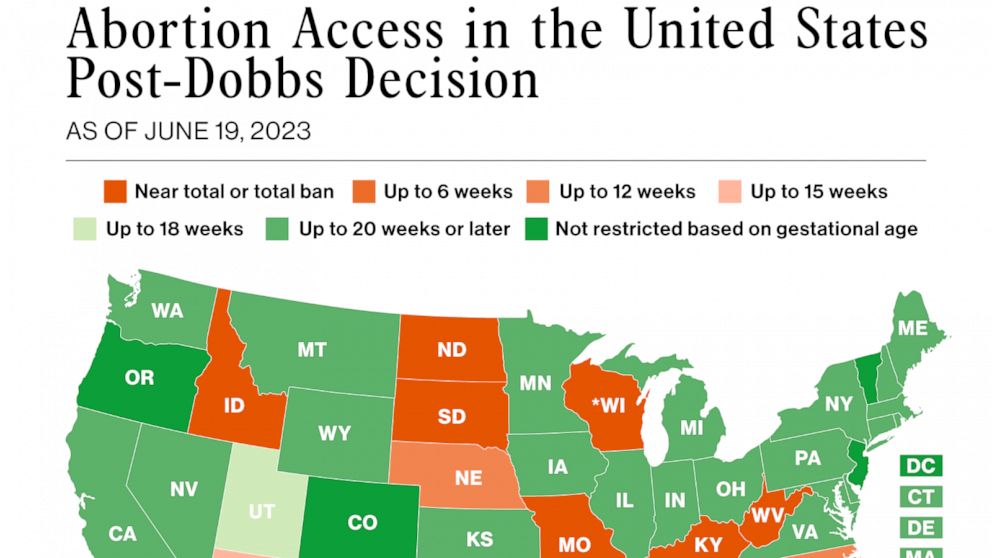


This weekend marks the one-year anniversary of the Supreme Court overturning Roe v. Wade, a decision that gave states the power to make their own laws on abortion.
Since the decision -- known as Dobbs v. Jackson Women's Health Organization -- the abortion landscape of the U.S. has dramatically changed, including where bans are in place, how many abortions are performed in states and the support levels for abortion.
Here's what one-year post-Roe looks like in graphics:
Before the Dobbs decision, Oklahoma and Texas were the only states with bans restricting abortion after 20 weeks, state laws show. Other states tried to pass similar bans, but saw those efforts blocked by judges,
Since the decision, released on June 24 of last year, at least 15 states have ceased nearly all abortion services, according to an ABC News tally.
Thirteen states have near-total or total abortion bans: Alabama, Arkansas, Idaho, Kentucky, Louisiana, Mississippi, Missouri, North Dakota, Oklahoma, South Dakota, Tennessee, Texas and West Virginia. Georgia has a six-week ban.
MORE: A year after Roe's overturning, here are the states working to strengthen abortion accessWisconsin providers have also stopped performing abortions, but this is due to confusion about the status of the state's pre-Roe ban, according to the Guttmacher Institute, a research group that focuses on sexual and reproductive health.
Other restrictions in the U.S. include a 12-week ban in Nebraska at present, and North Carolina beginning next month; a 15-week ban in Arizona and Florida; and an 18-week ban in Utah.
Since the Dobbs decision, thousands of people have been unable to obtain abortions in their home states or neighboring states.
Estimates from #WeCount, a research project from the nonprofit Society of Family Planning -- and provided exclusively to FiveThirtyEight -- showed there were 24,290 fewer legal abortions from July 2022 to March 2023 compared to a period before Dobbs.
The number of abortions per month in each state, compared to the averages before Dobbs, rose or fell depending on the legal status of abortion in the state, the estimates showed.
While support for abortion was high in the U.S. prior to the Dobbs decision, it has now increased.
This is especially true when it comes to views on abortion by trimester. A Gallup poll published last week found 69% of respondents believe it should generally be legal in the first three months of pregnancy, a record-high and two percentage points higher than last year.
Although support for abortions in the second and third trimesters was lower than for the first trimester, record-high numbers were in favor of the procedure in later stages of pregnancy, the poll found.
MORE: Majority of OB-GYNs believe overturning Roe led to more maternal deaths: SurveyThe poll found 37% of respondents supported second-trimester abortions and 22% supported third trimester abortions, up from 36% and 20%, respectively.
Abortion providers in states where the procedure remains legal and who offer telehealth services say they've seen an increase in patients since the Dobbs decision.
Planned Parenthood of Illinois said in a release this month it has seen a 54% increase in abortion patients, both those receiving medication abortions and surgical abortions.
Hey Jane, a virtual clinic that mails abortion pills, said in a report published Tuesday it had seen a 164% increase in the last year.
The end of Roe v. Wade put power back in the hands of states to determine abortion access.
Since the start of 2023, nearly 700 abortion bills have been introduced in state legislatures across the country, according to the Guttmacher Institute, a reproductive rights organization.
This year has seen 25 measures enacted restricting abortion access and 30 protecting and expanding abortion access, according to Guttmacher.